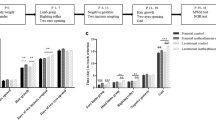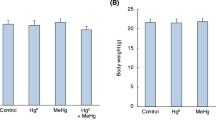Abstract
Methylmercury chloride (MMC) was given to pregnant rats on the 6th, 7th, 8th, and 9th day after conception in doses of 0.05 and 2.0 mg/kg/day. The female offspring of these animals were tested 90 days after birth for learning ability using operant conditioning procedures. The rats were kept at 90% of their normal body weight and trained in a lever-box to press a bar in order to obtain a food pellet.
Significant differences in the acquisition speed became apparent when the ratio of bar presses to reward was increased in a classical contingency of differential reinforcement of high rates even at MMC-doses of 4 × 0.05 mg/kg. These differences were not found in the general motility level nor in motor coordination.
Zusammenfassung
Trächtige Ratten erhielten am 6., 7., 8. und 9. Tag der Gravidität Methylquecksilberchlorid (MMC) in Dosen von 0,05 und 2,0 mg/kg/Tag. Die weiblichen Nachkommen dieser Tiere wurden 90 Tage nach der Geburt mit Hilfe der Konditionierung operanten Verhaltens auf ihre Lernfähigkeit hin getestet. Die Tiere wurden auf 90% ihres Normalgewichtes herabgesetzt. In einer Skinnerbox wurden sie darauf trainiert, für den Erhalt von Futter einen Hebel zu drücken.
Signifikante Unterschiede traten bereits nach 4 × 0,05 mg/kg MMC auf, wenn die Tiere in dem klassischen Konditionierungsprogramm “Differential Reinforcement of High Rates” den Hebel innerhalb einer vorbestimmten, kurzen Zeitspanne zunehmend häufig drücken mußten, um Futter zu erhalten. Die allgemeine Motilität und die motorische Koordination waren unverändert.
Similar content being viewed by others
References
Angermeier, W. F.: Kontrolle des Verhaltens. Berlin-Heidelberg-New York: Springer 1972
Bache, C. A., Gutenmann, W. H., Lisk, D. J.: Residues of total mercury and methylmercuric salts in lake trout as a function of age. Science172, 951–952 (1971)
Berglund, F., Berlin, M.: Human risk evaluation for various populations in Sweden due to methylmer- cury in fish. In: Chemical Fallout (M. W. Miller, G. G. Berg, eds.), pp. 423–432. Springfield, Ill.: Thomas 1969
Diehl, J. F., Schelenz, R.: Quecksilber in Lebensmitteln. Medizin und Ernährung12, 241–249 (1971)
Ferster, C. B., Skinner, B. F.: Schedules of reinforcement. New York: Appleton-Century-Crofts, Inc., 1957
Graham, T. M., Marks, A., Ershoff, B. H.: Effects of prenatal X-irradiation and discrimination learning in the rat. Proc. Soc. exp. Biol. (N.Y.)100, 78–83 (1959)
Haley, T. J.: Changes induced in brain activity by low doses of X-irradiation. In: Effects of ionizing radiation on the nervous system. IAEA, pp. 171–185. Vienna 1962
Kimble, G. A. (ed.): Conditioning and learning, 2nd ed. New York: Appleton-Century-Crofts, Inc. 1961
Kimeldorf, D. J., Hunt, E. L.: Ionizing radiation: Neural function and behavior. New York: Academic Press 1965
Knöppler, H., Dorn, P.: Personal communication 1977
Koronowski, P.: Nebenwirkungen von Quecksilberverbindungen auf Mensch und Tier. Mitteilungen aus der Biologischen Bundesanstalt für Land- und Forstwirtschaft, S. 153. Berlin-Dahlem, 1973
Matsumoto, H., Suzuki, A., Morita, Ch., Nakamura, K., Saeki, S.: Preventive effect of penicillamine on the brain defect of fetal rat poisoned transplacentally with methyl mercury. Life Sci.6, 2321–2326 (1967)
Murakami, U.: Embryo-fetotoxic effects of some organic mercury compounds. Annual Report of the Research Institute of Environmental Medicine, Nagoya University18, 33–43 (1971)
Schelenz, R., Diehl, J. F.: Quecksilbergehalte in Lebensmitteln des deutschen Marktes. Z. Lebensmitt.- Untersuch.-Forschg.151, 369–375 (1973)
Spyker, J. M., Sparber, G. B., Goldberg, A. T.: Subtle consequences of methylmercury exposure: Behavioural deviations in offspring of treated mothers. Science177, 621–623 (1972)
Symposium on Current Status of Behavioral Pharmacology. 58th Annual Meeting of the Federation of American Societies for Experimental Biology, Atlantic City, N.J., April 1974. Fed. Proc.34, 1832–1867 (1975)
Verschuuren, H. G., Kroes, R., den Tonkelaar, E. M., Berkvens, G. M., Hellemann, P. W., Rauws, A. G., Schuller, P. L., van Esch, G. J.: Toxicity of methylmercurychloride in rats. Toxicology6, 85–123 (1976)
Walkers, S., Furchtgott, E.: Effects of prenatal X-irradiation on the acquisition, extinction and discrimination of classically conditioned response. Radiat. Res.42, 120–128 (1970)
Winneke, G., Brockhaus, A., Baltissen, R.: Neurobehavioral and systemic effects of longterm blood lead-elevation in rats. Arch. Toxicol.37, 247–263 (1977)
Author information
Authors and Affiliations
Rights and permissions
About this article
Cite this article
Müsch, H.R., Bornhausen, M., Kriegel, H. et al. Methylmercury chloride induces learning deficits in prenatally treated Rats. Arch Toxicol 40, 103–108 (1978). https://doi.org/10.1007/BF01891964
Received:
Issue Date:
DOI: https://doi.org/10.1007/BF01891964




